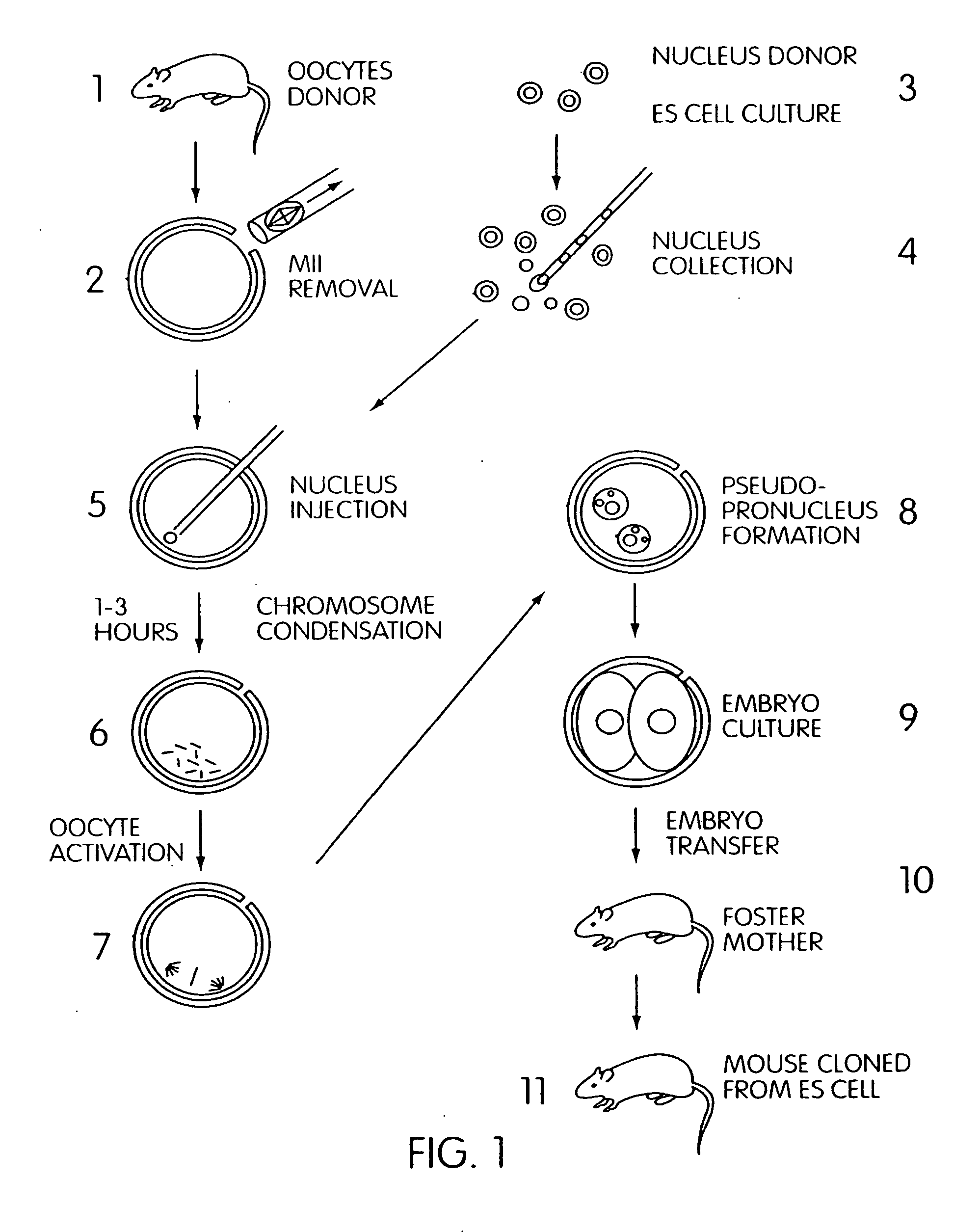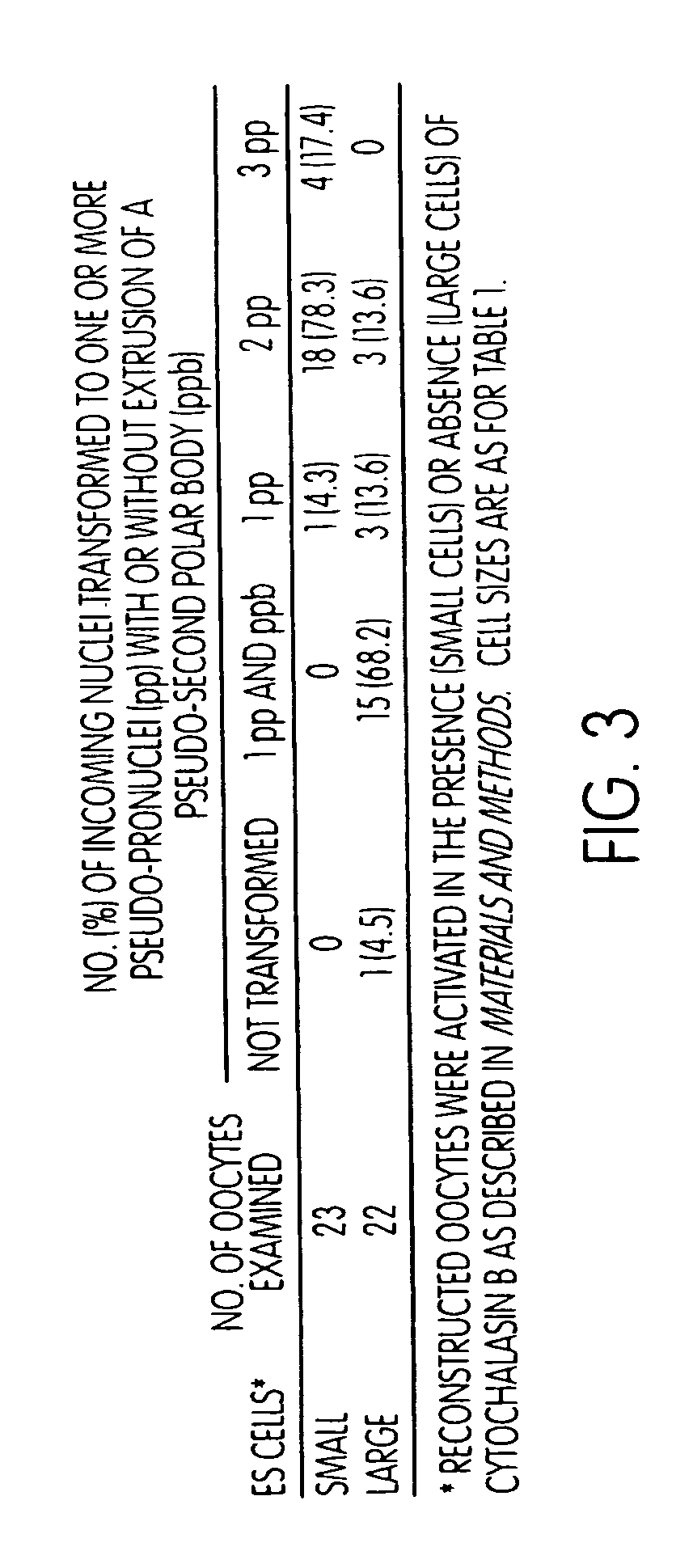Method to produce cloned embryos and adults from cultured cells
a technology of cultured cells and embryos, applied in the field of clone embryos and live offspring from cells, can solve the problems of inability of es cells to program full-term embryonic development, direct embryonic development, and both cell fusion and microinjection methods to date suffer, so as to improve speed and efficiency
- Summary
- Abstract
- Description
- Claims
- Application Information
AI Technical Summary
Benefits of technology
Problems solved by technology
Method used
Image
Examples
example 1
Preparation of Nuclear Donor Cells from the % Well-Established ES Cell Line, E14
[0120]This example utilizes the well-established and widely available ES cell line, E14 as the source of nuclei for microinjection into enucleated mouse oocytes. The E14 cell line was derived from strain 129 / Ola mouse blastocysts (Hooper, et al., Nature 326, 292 [1987]). The 129 / Ola parent strain is homozygous for the A (agouti) gene, with a chinchilla coat color that reflects its cchp / cchp genotype (chinchilla coat coloring is a soft-yellow). The ES cell line, E14, was derived from one such mouse strain; 129 / Ola, in the laboratory of Dr. Martin Hooper in Edinburgh, UK. To recognize offspring cloned from ES cell nuclei by the coat color of said offspring, it is necessary to select oocyte donor and foster mother strains whose coat colors differ from that of the mouse strain from which the ES cell is derived. In one embodiment, the nuclei of E14 cells (genetically chinchilla) are transferred into enucleate...
example 2
[0141]Experiments were performed in which enucleated oocytes were microinjected with the nuclei of cells from a variety of ES cell lines, exemplifying well-established cell lines originally derived from both inbred and F1 strains of mice. We describe the generation offspring in experiments in which nucleus donor ES cells were cultured in a variety of conditions and further demonstrate the method of the invention with donor cells of different ploidy.
[0142]The fate of ES cell chromosomes following nuclear transfer into enucleated oocytes. In experimental Series 1 (FIG. 2), enucleated oocytes received E14 nuclei but were not subjected to an activating stimulus. Such reconstituted oocytes therefore remained in mII. When examined 2-4 hours after microinjection of the nuclei of small cells, 51% of reconstituted oocytes possessed condensed chromosomes arranged in a scattered fashion. By contrast, 68% of oocytes injected with nuclei from large cells possessed cond...
example 3
Cloning with the Nuclei of Gene Targeted ES Cells
[0152]The utility of the method is illustrated by its use to generate offspring from an ES cell line containing a targeted mutation.
[0153]Generation of gene-targeted ES cells. ES cell lines harboring a targeted mutation were derived from E14. This line (described by Zheng & Mombaerts; submitted for publication) was generated by electroporating E14 cells with an M72→VRi2-IRES-tauGFP construct and subsequently cultured as described (Mombaerts, et al., Cell 87, 675 [1996]). One resultant cell line which carried the mutation, T15, yielded chimaeras with extensive colonization of somatic tissues and the germ line following blastocyst injection. We therefore assessed the ability of this line to provide nucleus donors in the method of the cloning invention.
[0154]Development of mice cloned from the gene-targeted E14 cell line, T15. Small T15 cells (with an estimated average diameter of approximately 12 μm and ploidy of 2n, 2C) were selected a...
PUM
| Property | Measurement | Unit |
|---|---|---|
| period of time | aaaaa | aaaaa |
| diameter | aaaaa | aaaaa |
| diameter | aaaaa | aaaaa |
Abstract
Description
Claims
Application Information
 Login to View More
Login to View More - R&D
- Intellectual Property
- Life Sciences
- Materials
- Tech Scout
- Unparalleled Data Quality
- Higher Quality Content
- 60% Fewer Hallucinations
Browse by: Latest US Patents, China's latest patents, Technical Efficacy Thesaurus, Application Domain, Technology Topic, Popular Technical Reports.
© 2025 PatSnap. All rights reserved.Legal|Privacy policy|Modern Slavery Act Transparency Statement|Sitemap|About US| Contact US: help@patsnap.com



